Modern mothers not only follow fashion themselves, but also strive to teach their daughters to look beautiful from birth. A tutu skirt for little girls can be made quickly and easily with your own hands.
How to choose tulle for a tutu skirt?
Tulle is a mesh synthetic fabric., from which ballet tutus are sewn. The material differs in rigidity. The rougher it is, the better it holds its shape. This fabric is used to make brooches, hairpins, theatrical draperies, large and small design elements. This category of tulle is not suitable for sewing clothes, as its rigid edges can damage tights and other synthetic products.
Medium-stiff fabric is used to make flowers and petticoats for elegant dresses. Soft tulle creates the impression of extraordinary tenderness and airiness. Expensive skirts and dresses are sewn from it, because tens of meters of fabric are required to give the product splendor.
Fatin is:
- plain with shine;
- matte;
- decorative (with embroidery, rhinestones, with a beautiful flocked coating).
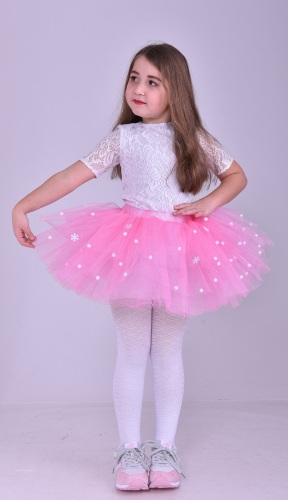
Calculation of fabric for a fluffy skirt for a girl 1-3, 5-6-7 years old
A tutu skirt is often made by needlewomen for girls of preschool and primary school age from ready-made rolls 15 cm wide.
The length of such a strip on a spool is 22.5 m. The skein is enough for 40 double strips, which are required to create half of a fluffy skirt for a one-year-old baby.
For the entire skirt, two rolls of the same or different colors are enough.
The table provides data that allows you to understand who benefits from buying tulle in rolls if you don’t want to have unused material left over.
| Age, years | Length of double strip, cm | Number of rolls, pcs. |
| 1 | 60 | 2 |
| 4 | 90 | 3 |
| 7 | 120 | 4 |
When making for children between 1 and 7 years of age, it is more convenient to cut the fabric yourself 1.5 m or 3 m wide. 10 or 20 15-centimeter strips are laid out in width. A minimum of 80 double cuts are needed for a non-transparent skirt. For a width of 3 m, which is sold everywhere, 4 double lengths of the product are set aside in length.
How to dye tulle in the desired color?
Instructions for using any color dye for synthetic materials:
- The dye should be dissolved in a small amount of boiling water for better and faster coloring.
- The fabric should be washed and rinsed.
- Next, you need to fill a large container that cannot be painted with a sufficient amount of lukewarm water.
- Add the dissolved dye here and stir.
- Place the tulle into the dye bath. It should be completely immersed.
- Boil the fabric in this solution for 10 minutes, stirring constantly.
- Add 4 level tablespoons of table salt for every 4 liters of water. Cook for 20 minutes, stirring continuously.
- Remove the fabric and rinse under running water until a completely colorless liquid flows out.
- Squeeze the tulle with your hands, straighten out the folds, wrap it in a towel and iron it while it is still damp. Do not try to dye dark tones light.
Synthetics do not like high temperatures. The only advantage of home dyeing is the ability to create stains on the fabric by tying it or knotting it in the right places.
How to sew a fluffy tulle skirt without a sewing machine?
Since tulle is not a loose material, you can make a skirt from it without a sewing machine. To do this, you will need the above-mentioned 15 cm wide rolls of fabric, spander (rubber) thread, a 3 cm wide elastic band for the waist, scissors, and cardboard of a length equal to the length of the product.
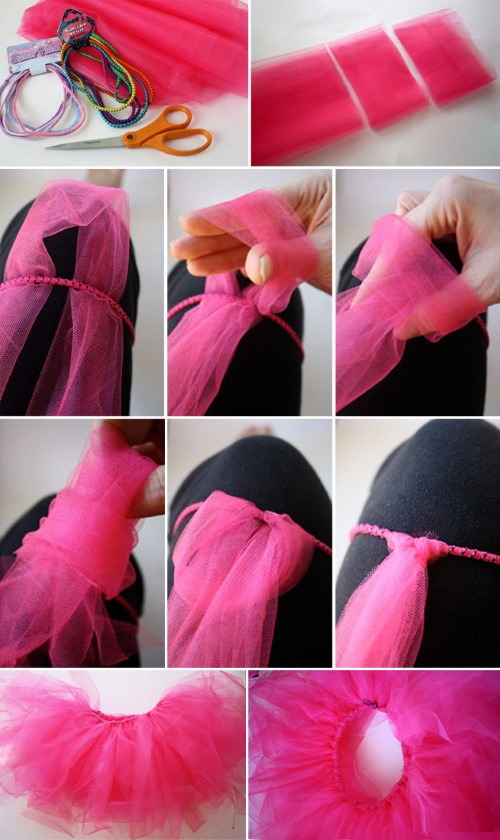
Next:
- The tape is wound onto a cardboard form.
- They cut at a right angle along the side of the cardboard from which they started winding. The resulting blanks are double length.
- Measure the waist length.
- The elastic, 3 cm shorter than this length, is sewn by hand.
- They put it on any support, for example, on 2 legs of an inverted chair.
- Cut off a long piece of spanner.
- Place two ribbons together and place the middle part on top of the elastic band.
- The bottom of the elastic band is wrapped with spander thread and tied into a knot. Wrapped a second time and tied again.
- The process is repeated with the next two blanks. In this way, the entire elastic is filled. The skirt requires 90 pieces of tulle. They can be of different colors and alternate as desired.
- At the end, the thread is secured. For reliability, you can go along the waist with the spanner a second time.
- To create splendor, the ribbons that stick together in pairs are separated. The skirt turns out very airy.
The second method is even simpler and faster:
- The same double blanks are taken one piece at a time and folded in half.
- The middle is tucked under the elastic waistband.
- The ends are pulled through the resulting loop from below. The tape is securely fastened.
- The same is done with the remaining pieces.
The product is ready in just a few minutes.
Master class on sewing a tutu skirt with your own hands
Making a tutu skirt does not require any special skills.
Cutting a multi-layered skirt
A do-it-yourself tutu skirt for a girl aged 5-7 requires simple cutting. With a fabric width of 1.5 m, to sew the product, it is enough to divide it into 3 parts to get a skirt length slightly less than 0.5 m.
You will also need:
- a piece of stretch fabric for the cover;
- 2.5 cm wide elastic band for the waist;
- threads of matching color;
- scissors;
- chalk.
Sewing sequence:
- The tulle is laid out on the table.
- On each side, the following values are marked in sequence with chalk: length of the product L; segment L - 10 cm; L - 20 cm.
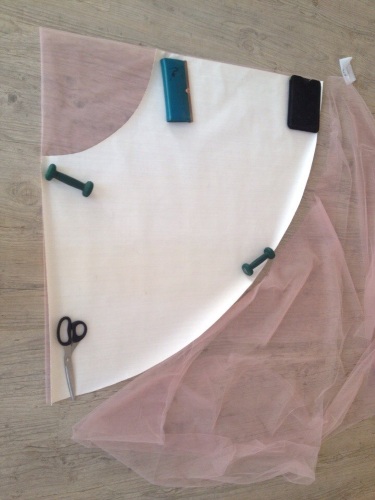
- The fabric is folded along the lines of the corresponding points on both sides and cut.
- Each of the three resulting pieces is stitched along the edge with large stitches.
- These threads are pulled to the length of the child's waist.
- From stretch fabric, cut out a rectangle with a width equal to the hip circumference and a length equal to the narrowest cut + 6 cm.
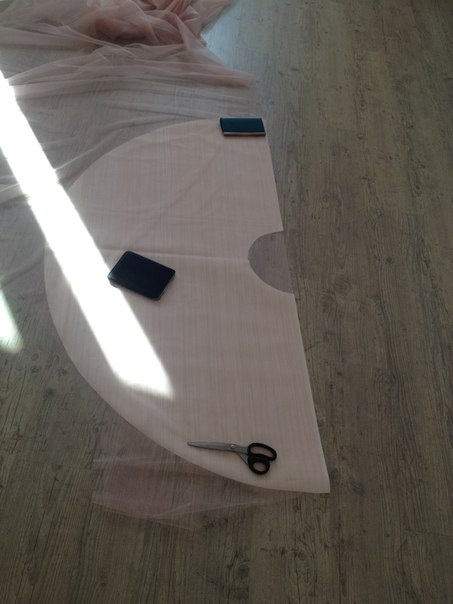
- It is hemmed or processed with a zigzag stitch from below.
- Using a marker or chalk, draw a line on the future cover at a distance of 6 cm from the top edge.
- All three pieces of tulle are applied to this place, starting from the longest one, and stitched.
- The stretch indent is slightly folded at the raw end, folded in half and sewn, leaving an opening for inserting the elastic.
- They pull the elastic through and sew it together.
- They sew up the hole.
Sewing a classic tutu
A do-it-yourself tutu skirt for a girl taking her first steps in dancing can be sewn from 4-6 layers of tulle. It is sewn from rectangular strips, the width of which decreases layer by layer by 2-3 cm. Professionals sew a tutu from 12-16 layers of fabric.
You can take the average difference to reduce the width of each layer - 2.5 cm. The number of skirts is 4. With a fabric width of 3 m, the cut length is taken to be at least 3 m. You will need skirt lengths of 37.5 cm, 35 cm, 32.5 cm, 30 cm.
Step by step instructions:
- You need to lay out the tulle on the table and cut off 2 strips 37.5 cm wide.
- Sew them together with the narrow side.
- Divide 3 m by the length of the waist circumference. If it is 50 cm, then it will be 6 times. This means that the long edge of the tape needs to be reduced by 6 times due to overlapping folds. To avoid mistakes, mark with chalk every 30 cm. On this section, the length of the product should be 5 cm. The thread is selected strong, the needle is thick enough. The same is done with the remaining three strips. If this operation seems difficult, each strip will need to be stitched and pulled to the length of the waist circumference. The accordion will be very dense, and the thread will still need to be reliable. In this case, it is better to stitch in 2 rows.
- Sew each gathered strip to the panties one above the other as tightly as possible. At the top is the widest piece for the skirt, at the bottom is the narrowest. It is easier to sew each piece to a piece of tape, and sew the tape to the panties, slightly stepping back from the previous seam. It will be more reliable if you sew the tutu to the bodysuit. If you fasten all the elements on a wide belt, it will also look good. Do not forget that the skirt is intended for a complex dance and opens the area below the belt. Such fastening, as in the picture, provides the product with the necessary rigidity.

- The skirt is straightened on the table, placing it face up.
- The layers are manually fastened vertically to each other with very weak stitches, either like a quilt, or in concentric circles. The purpose of this action is to prevent the layers from flying apart when moving. Therefore, there is no need to compress the product. If you want to make a complete resemblance to a real artistic tutu, a thin plastic or metal hoop is inserted into one of the concentric circles. These are sold in wedding dress shops. You can also make do with wire.
Tutu skirt for newborns
For sewing you will need 2 pieces of tape measuring 20x4 cm. The elastic band, measuring 50x2 cm, should not be compressed. A wide bra strap will do for it.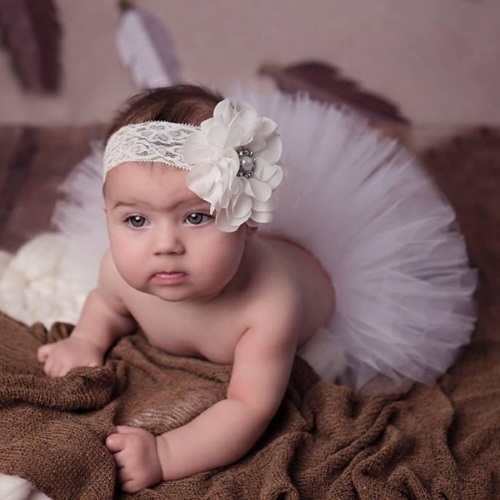
- The edges of the tape are burned.
- Take one, fold the cut by 0.5 cm and fold it in half lengthwise, grasping the edge of the elastic band.
- The parts are sewn tightly together with two lines.
- The same action is repeated from the other end of the elastic band.
- Soft, double-length tulle ribbons are cut from a roll.
- The elastic band is tied on the back of the chair.
- Take each strip in the middle and tuck it under the elastic band.
- The ends are pulled through the resulting loop from below.
- All the pieces are knitted.
- The first and last strips are pulled over the place where the tape and elastic are sewn together and secured with several stitches by hand from the wrong side.
Due to the fact that the elastic is hard and does not wrinkle, the belt turned out neat, the same width along the entire length. The skirt is tied with ribbons around the baby's waist. There will be enough stock to even grab a diaper.
Model with satin ribbons
The skirt can be made in one color or multi-colored. To get the first option, it is enough to replace all the colors with one.
You will need:
- 3 rolls of tulle, 15 cm wide;
- scissors;
- cardboard template;
- 30 cm ruler;
- 3 pieces of satin ribbon to match the tulle, 1.5 m of each color;
- openwork elastic waistband with three rows of holes (up to 50 cm);
- sewing machine;
- 3 colors of thread to match the machine tape;
- 2 pieces of elastic, 40 cm each.
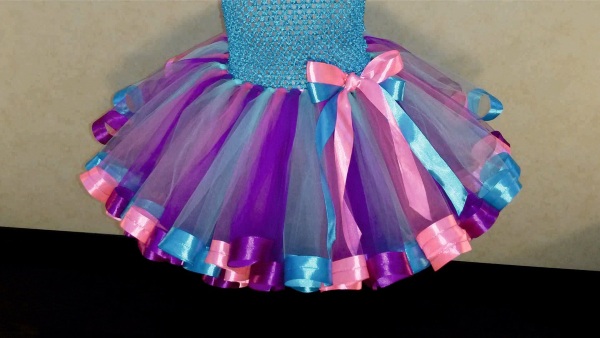
The cardboard template should be 1 cm longer than the length of the product, since approximately this much material will be used for the knot.
- The beginning of the fabric is placed 1-2 cm behind the cardboard and held with your fingers so that it does not move and the piece is not shorter than the others.
- Wind 30 turns of tulle without tension and cut along the side of the cardboard border.
- Cut the tape into 15 cm long pieces.
- Take 3-4 pieces in each hand and burn the edges over a lighter.
- They sit down at the sewing machine.
- They put down the tape.
- The edges of the ribbon and tulle are aligned, turning the tulle so that it wraps outward from the ribbon. The thread tension is medium, the stitch is slightly larger than average.
- The parts are placed under the foot.
- The seam is made in the middle of the tape. As soon as the fabric appears behind the foot, grab it with your hand and pull it up so that there are no gathers.
- Turn the tulle over to the opposite side and sew the ribbon onto it in the same way.
- This operation is done with all pieces of fabric.
- The thread remaining after cutting on both sides of each seam is tied so that the ribbon forms rings with the face out.
- The pieces of fabric with ribbons are taken in the middle and slightly folded, and also aligned along the entire length so that they do not skew or stick out, and keep the shape of the cylinders.
- In this form, the middle of the tape is pushed through the lower hole in the lace of the waist elastic.
- The ends of the fabric are pulled through the resulting loop.
- A ribbon of the second color is tied into the second row of holes, and a ribbon of the third color is tied into the top row.
- In the next vertical, the colors shift by 1 row. The shift continues through all the verticals. The position of the colors is repeated every 3 rows.
- This way the entire volume of the pack is filled. The skirt comes out very fluffy and bright.
- To secure the waistband, use a safety pin to pull a piece of elastic through the top row and sew it in place.
- The second elastic band is inserted into the holes of the bottom row of the waist elastic band.
- Its edges are sewn together.
The skirt can be decorated with a bow made of ribbon of one of the colors and other accessories.
Long tutu skirt
A tutu skirt made by hand for a girl aged 5-7 years can be long. A flared sun skirt is a suitable style for this option.
You will need:
- a piece of soft tulle;
- elastic waistband;
- fabric for petticoat.

Working on the skirt step by step:
- The waist circumference and length of the product are measured.
- It is necessary to cut out a wedge equal to a quarter of the skirt. The pattern is made on thick paper the size of 1/4 of the fabric. On one side, the radius is set aside, equal to 1/6 of the waist circumference, and the length of the skirt.
- The same is noted on the adjacent side near the designated radius.
- Similar points on adjacent sides are connected by segments of a circle with the center at the apex of the common angle. To do this, one end of a piece of the required length is held with one hand at the center of the waist circumference; the other end with chalk is used to draw arcs.
- The fabric is folded into a booklet in four layers.
- The pattern is pinned to the fabric and the cutting is done.
- The two resulting pieces are sewn together at the sides.
- A rectangle of the belt is cut out of tulle or other fabric, taking into account the folds.
- The piece is folded in half, the edges are tucked inward.
- An elastic band is inserted into the middle of it.
- The belt is stitched lengthwise.
- A rectangle of the petticoat is cut out to the width of the hips. The length is above the knee.
- It is stitched along the top and gathered to fit the waist size.
- The layers of the tutu, the more the better, are stacked on top of each other. A petticoat is added on top.
- Everything is placed on the wrong side of the belt and sewn on.
- The side seam of the pack is made.
- The cover is not sewn all the way so as not to restrict movement when walking.

- The bottom of the petticoat is hemmed or processed with a zigzag stitch.
Tutu
A full tulle skirt is also called a tutu. The basic base can be varied.
They look interesting:
- Skirts with trains.
- Plain skirts, on top of which stripes of a different color are intertwined in the form of a honeycomb (for this, a strip 1.5 times longer than the rest is tied to the belt after every 5 base strips).
- Tutus decorated with bows, flowers, rhinestones.
- Skirt with a yoke made of a different material.
- Tutu as an element of dress.
Tutu with sharp edges
Another technique adds variety to the products - this is giving the ends of the tulle strips a pointed, cut obliquely or symmetrical shape. With your own hands, such a tutu skirt for a girl is made quickly.
When cutting the tulle ribbon wound on the template, the cut is not made along a straight line, but along the selected configuration. A tutu with such edges looks even more magnificent. Light beads can be sewn onto the sharp ends. Bows made of thin ribbons, tied on the sharp ends at a certain interval, will distinguish the model from a number of similar ones.
Author: Svetlana Bulgakova
Article formatting: Vladimir the Great
Video on making a tutu skirt from tulle
How to make a fluffy tutu skirt in 1 hour:
